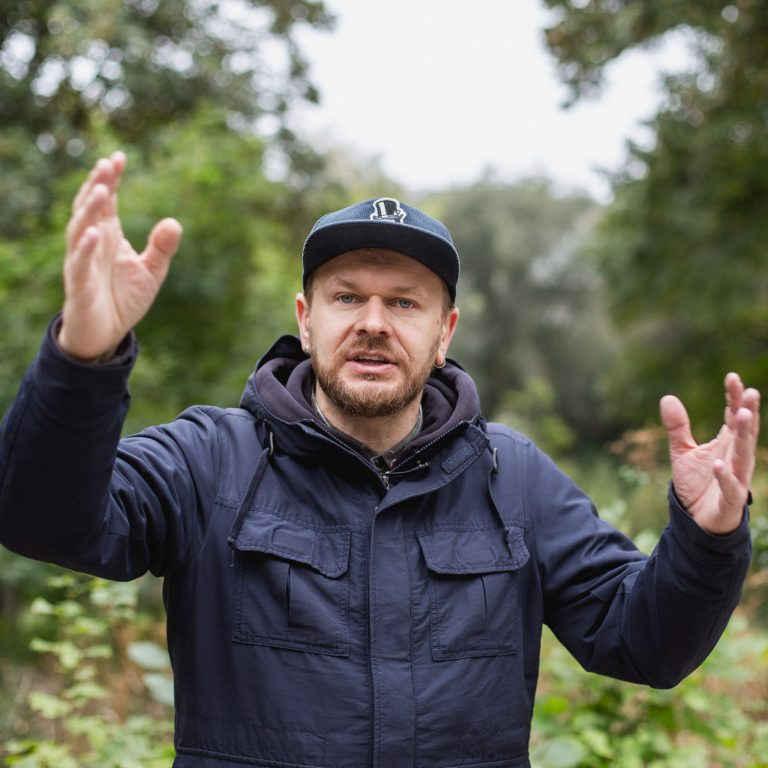In the Ambassadors series, famous Ukrainians give us a fresh look at the towns and cities where they grew up. In the ninth story, singer and showman Oleksandr Polozhynskyi introduces us to his hometown, Lutsk. Oleksandr, founder of the band Tartak (‘Woodsaw’ — tr.) and the Buv’ye project, recalls his childhood years in Lutsk and shows us how the city has transformed into a centre of modern art, progressive youth and inclusive education. Bogdan Logvynenko, the founder of the Ukraїner project, set off with Oleksandr for a tour of modern Lutsk.
The Volyn Botanical Garden remains one of the most popular areas to relax and have fun in Lutsk. The garden is also home to one of the city’s unofficial symbols: the Lutsk Elephant, a sculpture that is traditionally repainted in a different colour each year by local enthusiasts.
— Did you come to the botanical garden often?
— For a while, I used to do folk dance at the Palace of Pioneers (now the Youth Centre — ed.). In winter, on the way home, we liked to slide down the slope on plastic bags. The terrain here is very suitable for that. We used to hang out next to this elephant. By the way, the elephant keeps changing colour. I don’t know why that is. It’s quite possible that every time anyone has some leftover paint, they feel obliged to paint the elephant. This place hasn’t really been modernised, but I like it here. It has a vibe of its own.

The Volyn Youth Centre was created as a platform for events and educational programmes to develop the knowledge, skills and values of the local youth. Social activist Zakhar Tkachuk strongly believes that the residents of Lutsk should get involved in social life, and the centre is working hard to achieve this: “On average, we host two or three events per day. If you want to hold a meeting at 9 or 10 pm, you won’t find a place for it: the city hall closes at 6 pm, all the post-Soviet libraries close at 6 pm, so what can you do? That’s why we work round the clock. We’re thinking of setting up a hostel, but at this point we don’t have the resources for it. If you have a sleeping bag, you can stay overnight here. A lot of young people come here: FRI exchanges (‘Foundation of Regional Initiatives’, a Ukrainian youth organization — ed.), ‘Tvoya krayina’ (‘Your Country’, a non-profit network with an outreach programme around Ukraine — ed.), BUR. If they don’t have a place to spend the night, we usually tell them, “Sure, we don’t have any beds, but if you’re OK with that, feel free!”
BUR
‘Building Ukraine Together’, a volunteer and travel project aiming to develop young Ukrainians’ trust and responsibility towards their country.
— What was your childhood like?
— I grew up surrounded by animals. My father was the manager of a pet shop. At home I had every animal imaginable: all kinds of fish, parrots, canaries, hamsters, squirrels, chipmunks, guinea pigs… I even had a pet monkey! There was a lady in a village who had a monkey that lived in the yard. It was a present from her son, who was a sailor. She didn’t know what to do with the monkey, so it lived in a dog kennel on a chain. My father went to rescue the monkey, he bought it from the woman. Although it wasn’t exactly the jungle, living with us was much better than living on a chain in a kennel.
— Did you take part in the KVK comedy show in Lutsk?
— Yes, sometimes I did. (KVK is a TV comedy contest that originated in the Soviet period, in which teams compete to demonstrate their comic prowess — ed.). We didn’t call it KVK, though — we called it KVN, like the original, and picked words in Ukrainian to fit the original Russian abbreviation and keep the same meaning: ‘Jokers’ and Wits’ Club’.

Saint Peter and Paul Cathedral, and the Jesuit college attached to it, were founded by members of the Jesuit order in the first half of the 17th century. An extensive network of tunnels was created underneath the buildings, with premises including a temple, a refectory, jail cells and a chapel. During the Soviet times these were used for vegetable storage, while the cathedral itself was used as an office and workshop. The early 17th-century frescoes have been preserved in the underground chambers, as have the medieval metal grilles that were used to lock the passageways between the tunnels. Archaeologist Viktor Bayuk is certain that the ongoing archaeological excavations will allow for a better understanding of the complex: “The chambers are gradually being cleared out and we are opening up new galleries and niches. When we were dismantling the Soviet-era walls, we saw that all the alcoves had been raided except for one, which may be a burial place. We have the necessary documents and archive material to create a museum complex, to restore each room to its original appearance with its original contents.”
— What was this building used for when you were a child?
— During my Soviet-era childhood, there was a museum of atheism in the cathedral. I liked to come here often.

— What was it like?
— It was like a museum of the history of religion, of different religious beliefs. There were some torture instruments from the Inquisition. I remember being shocked by a tool that was used to strip off people’s skin.
— Was the underground complex open to visitors back then?
— It hadn’t been cleared out yet. Nowadays it’s been cleared out a bit, and that’s a whole other story. There was a man (Oleh Vynohradov — ed.) who was clearing it out himself, out of sheer enthusiasm. He set up a club here (a volunteer group called ‘Enthusiast’ — ed.) and enlisted the help of children and young people. He even used to live here and give guided tours, but sadly he isn’t with us any more.

One prominent representative of Lutsk is designer Kyrylo Tkachov, who moved here from Alchevsk, near Luhansk, in 2014. Kyrylo is the co-designer of the logos for Ukrzaliznytsia (Ukrainian Railways — tr.), the Zaxidfest rock festival, and the band Buv’ye. He also came up with fonts for the brand ‘Ukraine Now’ and the Ukraїner project. In order to create a space for designers in Lutsk, Kyrylo founded a festival of calligraphy, font design and book design called The Space of Letters, in which Ukrainian and foreign experts present, discuss and analyse the creative heritage of calligraphy and font design, as well as searching for new, contemporary styles. From his own experience, Kyrylo Tkachov has concluded that it is up to activists to organise events like this: “Ukraine has quite an active ‘font culture’, but there are no other events like this, and our festival is growing. At first we only needed a small venue, and now we have to hire a castle and come up with something really inventive. The Space of Letters festival is not just about calligraphy: it’s about everything related to letters. It’s about design, brand identity, books, film credits and lots more besides. Letters are all around us. They’re a part of our culture that we don’t always notice, but a crucial part nonetheless.”— How did you get acquainted with Kyrylo Tkachov?— I think I read or heard somewhere that some very active and creative people from Luhansk had come to Lutsk, given the city a new lease of life and created a new, modern space here. Then I met Kyrylo online.
— Do you know the origin of the name Lutsk?
— People say that the name is derived from the word ‘luk’ (the Ukrainian word for an archer’s bow — ed.) The city used to be called Greater Luchesk. The river Styr curves through the city in the shape of a bow — that’s probably where the name comes from.
— What should foreigners visit in the city?
— If foreigners are interested in getting to know this country, they can go to any Ukrainian town and just spend time there: walk around, look around, listen, and so on. The same goes for Lutsk.

— Why don’t you have any songs about Lutsk?
— I do have a song about Lutsk: it’s called ‘Staryi Lutsk’ (‘Old Lutsk’ — tr.). It’s a fresh story, actually. There’s a basketball team in Lutsk, which used to be called ‘Volynbasket’. They wanted to use our song ‘Lytsarskyi Khrest’ (‘Knight’s Cross’— tr.) as their anthem because the Volyn coat of arms is a cross, very similar to a knight’s cross. They also had a cross symbol on their uniform, so our song was ideal for them. However, for various reasons, the team no longer exists. Now there’s a new team called ‘Old Lutsk’. This summer (2019 — ed.) they asked me for permission to use the song ‘Stara Shkola’ (‘Old School’— tr.) as their anthem. I offered to write them something new, and they were thrilled with the idea. So now we’ve recorded that song with my band, Tartak.
— What is the story behind Tartak?
— Our springboard was Chervona Ruta (a biennial youth music festival in Ukraine — ed.). I’d been nursing the idea of a musical project for a while, but hadn’t dared to do anything about it. But when I saw an announcement for the knockout round for Chervona Ruta, I went to hand in my application. It turned out that I also had to write down the band members’ names and the titles of the songs we were going to perform, none of which existed at that point. The songs existed in my head, but without any musical arrangement, since I didn’t have a band. So I had to write down some names. I wrote down two names. One of those people still has no idea that he was in the original Tartak lineup, because I haven’t seen him since.

— How did you prepare to perform live?
— Tartak’s first ever performance was organised in two days. Well, I’m not sure if ‘organised’ is the word. The audio tracks were recorded two days in advance, and the band lineup was formed one day ahead of the performance. Of course we had no time to prepare three songs at such short notice.
— So you didn’t have any rehearsals?
— We basically went on stage without having rehearsed. I knew the lyrics, I could deliver the words, but I didn’t know back then that you can’t just deliver the words, you have to do it in a certain rhythm. In order to do that, I needed to practice a bit, especially since I had no experience whatsoever. So we started performing at a pretty fast tempo.. At some point I realised I was falling out of the song, I couldn’t keep up, my tongue was faltering. But I didn’t stop, I kept on singing. I pretended everything was fine. The sound quality wasn’t great and nobody could really hear the words, so I was mainly just expressing emotions and making sounds. And everyone was like “WOW”!

In 2016, the volunteer project ‘Braille Studio’ was launched in Lutsk, providing access to information for visually-challenged people. The team, headed by project supervisor Vitaliy Tkachuk, creates and distributes books and other resources printed in Braille. The print editor Oleksandr Melnyk points out that there are hardly any books printed in Braille in Ukraine. For Melnyk, one of their main goals is to promote this kind of publishing: “We print children’s books, fiction, books about Lutsk, sometimes English books. We don’t sell anything, since we are a community organisation and a charity. The city council allocates funds to us and we distribute books to specialised schools, libraries, and any providers of inclusive education. Our books don’t just go to Lutsk — we send them all around Ukraine.”
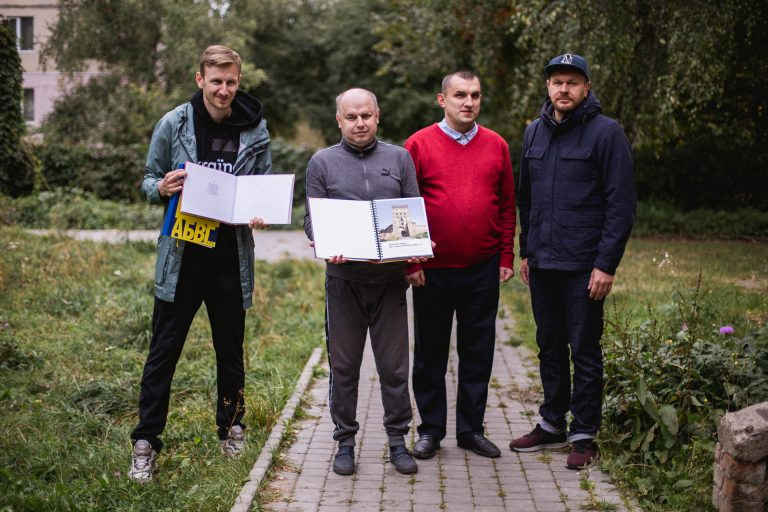
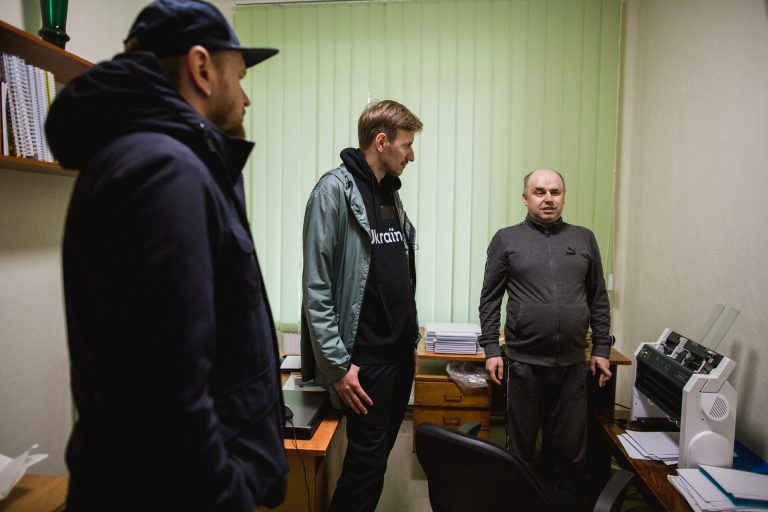
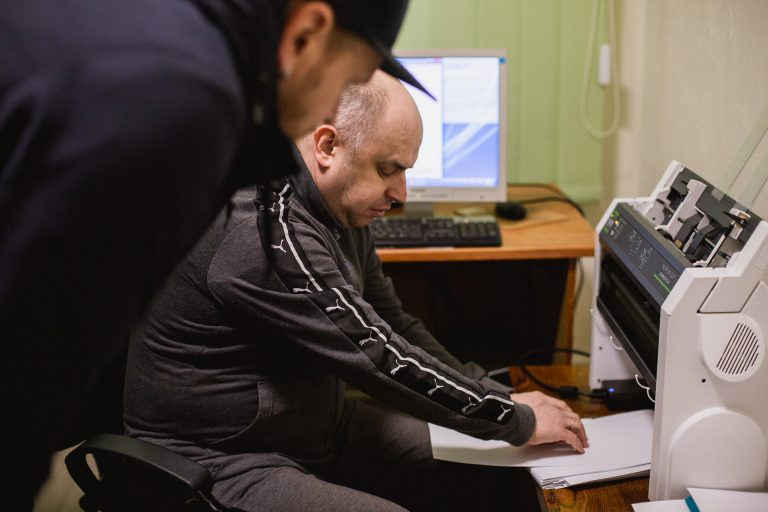
slideshow
— When did you move to Kyiv?
— I didn’t really decide — it was decided for me. I just accepted the offer. At the beginning of 1998, I got a call from the chart show ‘12 minus 2’. Fahot and Fozzy (members of the band TNMK — ed.) recommended me as a host. They called and told me there was a job vacancy: “If you want it, come and take it, but you have to be in Kyiv tomorrow or the day after.” Basically, I had one day to make up my mind. I didn’t hesitate.
— Do you recall the moment you had decided to come back to the capital?
— It was not like I decided. It was decided for me. I just accepted the offer. At the beginning of 1998, I got a call from the top chart called 12 minus 2 (a music show on the radiostation Promin, that was on air in the 1990s – editor). Fahot (Oleh Mykhailiuta – editor.) and Fozzey (Oleksandr Sydorenko – editor) recommended me as a host. So they called me and said that there was an open vacancy. “If you want, come and take it. If you take it you have to be in Kyiv the next day, or the day after the next one.” So I had one day to make up my mind. It didn’t take me long.

The Korsak Museum of Contemporary Ukrainian Art in Lutsk is located on the premises of a former leatherboard factory. The founder of the museum, Viktor Korsak, first opened a cultural and entertainment centre here, called ‘Adrenaline City’. The family also had a collection of contemporary Ukrainian artworks, and they eventually decided to found a museum on the basis of their collection. To this end, they purchased other parts of the factory premises and set up a museum dedicated to the Ukrainian painter and graphic artist Mykhailo Kubanovskyi. Later on, the museum’s permanent collection was established, alongside various temporary exhibitions. The museum is also the venue for a wide range of events, from children’s workshops to classical concerts. Co-founder Lesia Korsak believes that Ukraine is rich in high-quality contemporary art, and therefore strives to support young artists by providing them with a platform for exhibitions: “Oleksa Furdiyak’s arrow sculpture, ‘Up and Down’, has become the symbol of the museum. The artist welded it right here, from sheets of metal. We had to use winches to lift it up and then to paint it. It was the first exhibit in this hall. At first, there was nothing in this hall except for the arrow. According to Oleksa Furdiyak, this sculpture is a reflection on our Maidan (The Revolution of Dignity, which took place in 2013 – 2014 in Kyiv — ed.). Our hopes went up, then went flat, and then into decline. But this exhibit triggers a very positive reaction from our visitors. We look at it differently; we say that the message is about the renaissance of art in Volyn region, which will begin right here.”
— What are your impressions of the Korsak Museum of Contemporary Ukrainian Art?
— I don’t know yet, but some of the works raise my self-esteem as a painter.
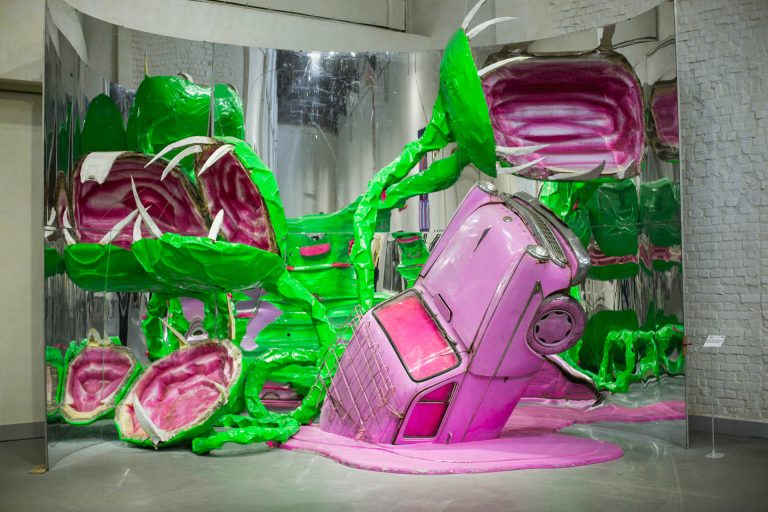
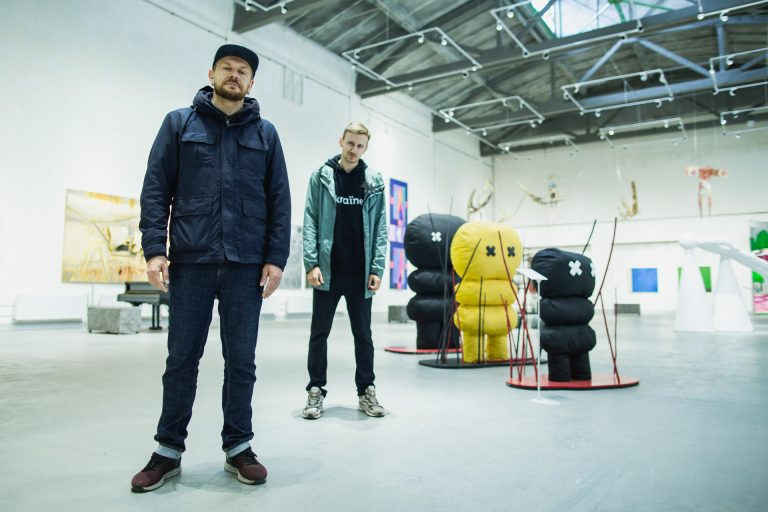
slideshow
— What modern Ukrainian music do you listen?
— I listen to a lot of stuff! ‘Ruky v briuky’ (‘Hands in trousers’ — tr.) is a band that plays rock ‘n’ roll and classical rhythm and blues. I finally made it to their concert for the first time and they introduced their first Ukrainian-language album. I devoured that album at once. I love music like that.
— What are you currently working on?
— I make a radio show dedicated to Ukrainian music, called ‘Zvuky pro’ (‘Sounds About’ — tr.). We’ve recorded a lot already and we keep making new broadcasts. I usually invite guests based on one of two criteria: either I like their personality, or I like their music and want to get to know the people behind it.

In the village of Zaturtsi, halfway between Lutsk and Volodymyr Volynskyi, is a museum dedicated to the political activist, historian and ideologist Viacheslav Lypynskyi. He was one of the first people who made a reasoned argument for the need to establish Ukraine as a state, and demonstrated how the interests of the people depend on the condition of the state. The restored estate of the Lypynskyi family houses a permanent exhibition dedicated to Viacheslav’s life and the milieu in which his family lived. Another exhibition is dedicated to Viacheslav’s brother, Stanislav Lypynskyi, who managed to preserve the family’s archives and belongings, which formed the basis for the museum. In the words of the museum director, Vitaliy Kushnir: “In 1871, Viacheslav’s father laid the foundations, but during the First World War, the house was razed to the ground. Later on, his younger brother Stanislav, the last owner of the estate, rebuilt the house on two floors. We believed it was necessary to dedicate the first room to Stanislav, since without his efforts we wouldn’t have a museum at all.”

— Which historical personality impresses you the most?
— In my opinion, Viacheslav Lypynskyi is one of the most important personalities in the history of Ukraine. I have huge respect for him. I would love for people to pay more attention to him; I wish his works, thoughts and views attracted more interest.

